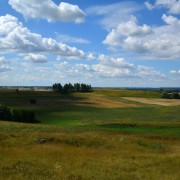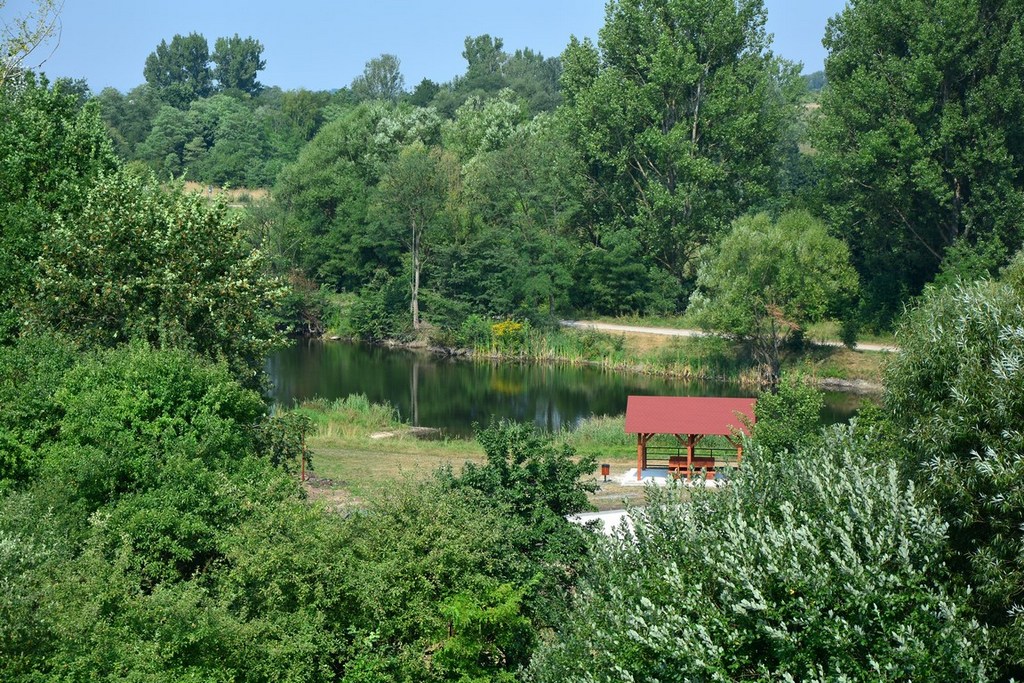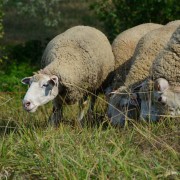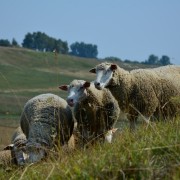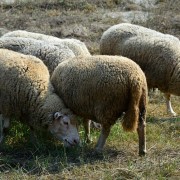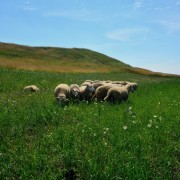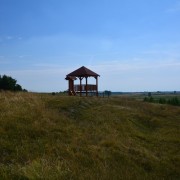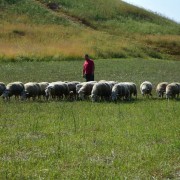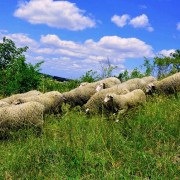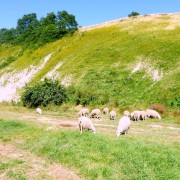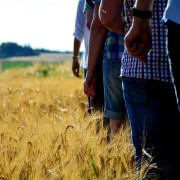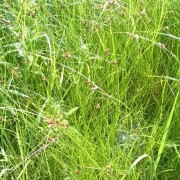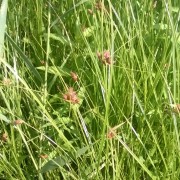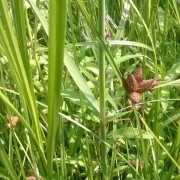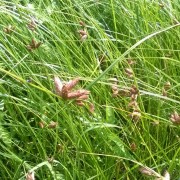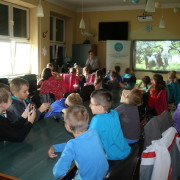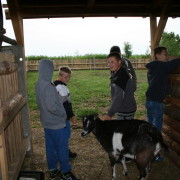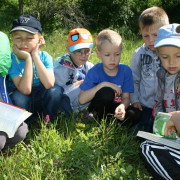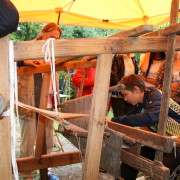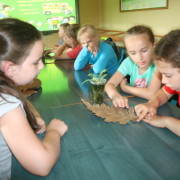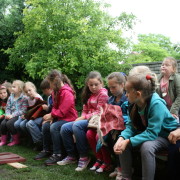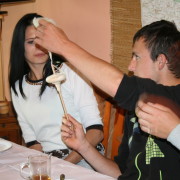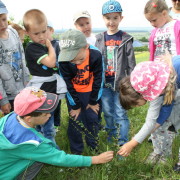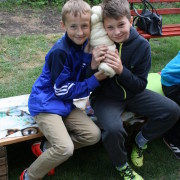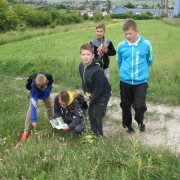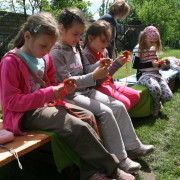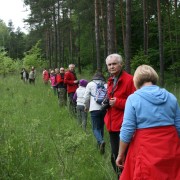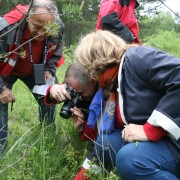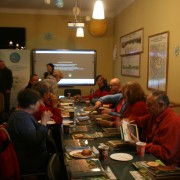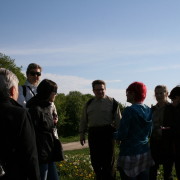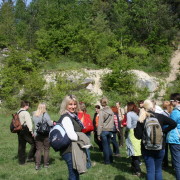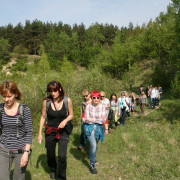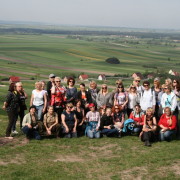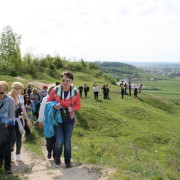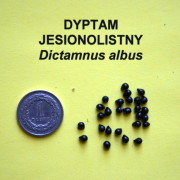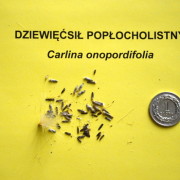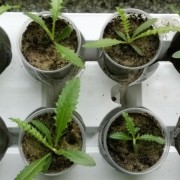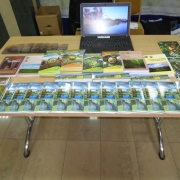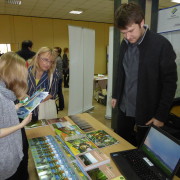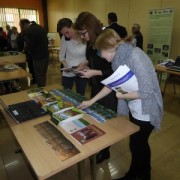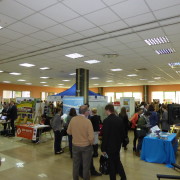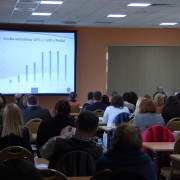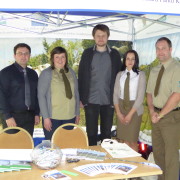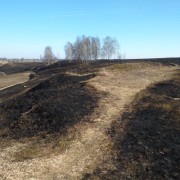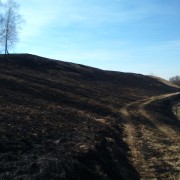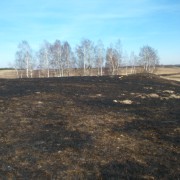News
The first flock of sheep went to the grazing land.
The pasture of first sheep started in Ostoja Stawiany on the slopes of Sobótczana Mountail. The flock is monitored all day long and surrounded with an electric fence. Also the feeding racks, drinking facilities and field shed where they can rest on hot days were provided. The animals were not pastured on xerothermic grassland before but they easily adapted to the conditions new to them. The result of their „work” can already be seen – high grass blades are eaten and uncovered soil is visible in certain places.
Those are the anticipated pasture results. This is to offer a chance to germinate to xerothermic plants. Moreover, the sheep distribute seeds and, obviously, fertilise the soil. Soon, it will be necessary to move the fence to the slopes of Dominikowa Mountain.
At the foot of Sobótczańska Mountain, near a small water pond, there was tourist infrastructure built (also within LIFE+ project), comprising a car park, shelter and bicycle stand. Information about the project and Ostoja Stawiany, as the Special Habitat Conservation Natura 2000 area can be found on the information boards while the landscape with Sobótczana and Dominikowa Mountains and feeding sheep can be admired from a new viewing platform erected on a hill on the other side of the valley.
This event attracted also TVP Kielce station. Here, you can find a link to the video: http://kielce.tvp.pl/21180556/owce-wrocily-na-ponidzie .
Visit to Xerothermic Grassland of Miechowska Upland.
As a part of creating a network of contacts, exchanging information and experience with other beneficiaries of LIFE+ programme, on 20 July 2015 the meeting with the representatives of the Regional Directorate for Environmental Protection in Krakow took place, carrying out LIFE12 NAT/PL/00056 project called „Conservation of Xerothermic Habitats in Natura 2000 Areas in Miechowska Upland”.
The visit started in the host’s registered office with a multimedia presentation, presenting the existing experience related to the performance of the said project. The next part of the meeting comprised field visits. In the areas of Natura 2000 Chodów – Falniów PLH120063, Cybowa Góra PLH120049 and Kalina Mała PLH120054, we got acquainted with the practical aspects of sheep pasture and conservation of xerothermic grassland
The visit proved very interesting. The abundance of information given to us, valuable theoretical and practical comments will surely contribute to the correct performance of the Ponidzie project.
Another meeting is scheduled for September.
Rare Halophyte in Górki
In one of the ponds in Górki near Wiślica we found a rare halophyte, called sea clubrush (Bulboschoenus maritimus). This is a collective species including smaller taxa, but they can be differentiated only after the seeds are seen (late summer or autumn). The sea clubrush is a facultative halophyte which means it can be found not only in salty areas. It rarely grows in reeds (often salty ones), especially at the sea side and e.g. along the Vistula river. Until now, we have known it solely from Owczary sanctuary. In the said habitat in Górki, it is found in a pond with water drained, over many dozen ares, creating a large homogeneous patch. Earlier, the underground bulbs of that plant, reaching the walnut size, were collected for food. Young, white or orange bulbs can be eaten raw like nuts while the older, blackish ones were used for making pancakes (they are too hard to chew).
The educational workshops JUNE 2015
From 15th to 23rd June 2015 a series of educational workshops related to the implementation of the LIFE13 NAT/PL/000038 Project titled „The protection of valuable natural habitats in Ponidzie” took place. Every day the meetings began with field sessions on selected natural habitats, during which students familiarised themselves with conditions in these plant communities. Depending on their age group, the participants would, among other activities: determine the pH of soil or, with help of a plant identification key, identify species inhabiting xerothermic grasslands and recognise protected plants such as: carlina onopordifolia, linum hirsutum or prunus fruticosa. After the field trip, students went to the agriculturism farm, where they learnt how to produce woollen thread out of sheep’s fleece, among other things. Moreover, they were taught to weave and create simple woollen objects. The workshops passed in atmosphere of fun and enjoyment and were accompanied by delicious refreshments prepared from organic products. The farm animals: goats, konik (Polish primitive horse) and dogs, whose presence aroused a lot of positive impressions and emotions among participants, have also contributed to the great ambience.
The tourist guides in Ponidzie.
On 23rd May 2015 in the didactic room of the head office of the Complex of Ponidzie and Świętokrzyskie Region Landscape Parksin KrzyżanowiceŚrednie a multimedia presentation of LIFE+ Project took place. The opportunity was provided by the visit of the tourist guides from the „Bartek” Union of PTTK Tourist Guides of Świętokrzyskie Region who participated in a tour of biologically and scenically outstanding locations of Ponidzie. The activities were organized by the Complex of Ponidzie and Świętokrzyskie Region Landscape Parks. The tour also ran through Byczkowska Mountain where, based on the example of the place, the participants were acquainted with the objectives of the proposed sheep grazing and the regulation of tourist traffic.
On 20th and 21st May 2015 in Krzyżanowice, in thehead office of the Complex of Ponidzie and Świętokrzyskie Region Landscape Parks a workshop titled „The use of media in educational and promotional activities; nature and press articles' editing” took place. During the course, on the first day of the workshop there was a multimedia presentation of LIFE+ project. The invited guests were, among others, representatives of local forest districts and the national park, engaged in conducting environmental education. They had an opportunity to familiarise themselves with main objectives of the project and methods applied to achieve the desired results. 35 people participated in the workshop.
We promote the project Life+ – May 2015
On 16th May 2015 in the head office of the Complex of Ponidzie and Świętokrzyskie Region Landscape Parks in KrzyżanowiceŚrednie a workshop for teachers affiliated with League of Nature Conservation took place. During the instruction LIFE13 NAT/PL/000038 project titled „Ochrona cennych siedlisk przyrodniczych na Ponidziu” („The protection of valuable natural habitats in Ponidzie”) was presented. The participants were acquainted with the main objectives of the project as well as the specifics of its implementation. 45 people participated in the workshop.
Ex situ conservation as a means of protecting rare plants in Ponidzie
Preparations to create a seed orchard in our head office in Krzyżanowice Średnie are underway. Within it, six very rare vascular plants selected for active protection as well as other species characteristic for Ponidzie will be planted. The first seeds have already been sown so as to get seedlings for planting in the orchard. This experiment has proven successful in case of Carlinaonopordifolia whose seedlings develop rapidly. On the other hand, the seeds of Dictamnusalbus have been undergoing cold stratification. The seeds harvested from the plants grown on the plantation will be sown in situ, in appropriate locations, so as to strengthen the population of rare, native species.
Face to face with nature – time to start the environmental monitoring.
In the beginning of May began the environmental monitoring conducted by experts from the Centre for Research and Environmental Control in Katowice. It aims to confirm the beneficial effects of the active protection treatments on the condition of selected natural habitats of high environmental value.
The first few dozens of transects for phytosociological research have been laid out and many rare species of flora and fauna typical for xeric grasslands (Campanula bononiensis, Lithospermumofficinale, Veronica austriaca and Noneapulla, among others), sandy, thermophilic, inland grasslands (Androsaceseptentrionalis, Valerianella sp., among others) as well as inland halophytes and thermophilic oak forests (Mellitismelissophyllum, Tanacetumcorymbosum, among others) have been found. Areas have been laid out, where trees and shrubs shading the habitats are planned to be cut down. The next phase of research will begin in the last week of May.
LIFE Information Day.
On 14th April 2015 a conference titled „DzieńInformacyjny LIFE” („LIFE Information Day”) organised by the National Fund for Environmental Protection and Water Management took place in Warsaw. It was mainly aimed to introduce to LIFE Programme individuals and institutions willing to apply for funds in future calls. The conference program also included presentations by LIFE+ beneficiaries, which reflected beneficiaries' experience of the implementation process of their projects and discussed emerging problems and ways of solving them. At the same time, at designated stands, presentations of individual LIFE+ projects took place.
Grass burning – a threat to environment
Unfortunately, the activity of grass burning, our country’s annual problem, has become increasingly common in spring. The persistence of a trend of inconsiderate torching of withered grass produces a death toll of insects, amphibians, reptiles and rodents which are killed directly; it also indirectly results in deaths of larger animals, namely: ducks, partridges and pheasants which are forced to search for new nesting sites. During the process of grass burning the entire microflora and microfauna is killed, and as a result – the soil impoverishes and its exposed surface becomes susceptible to erosion. Areas affected by grass burning remain lifeless deserts for many years as all life forms inhabiting them get destroyed. Threats to humans stem mainly from hazardous effects of smoke originating from the burning as well as directly from the fire. IT NEEDS TO BE REMEMBERED THAT GRASS BURNING IS AN ENVIRONMENTAL CATASTROPHE.













